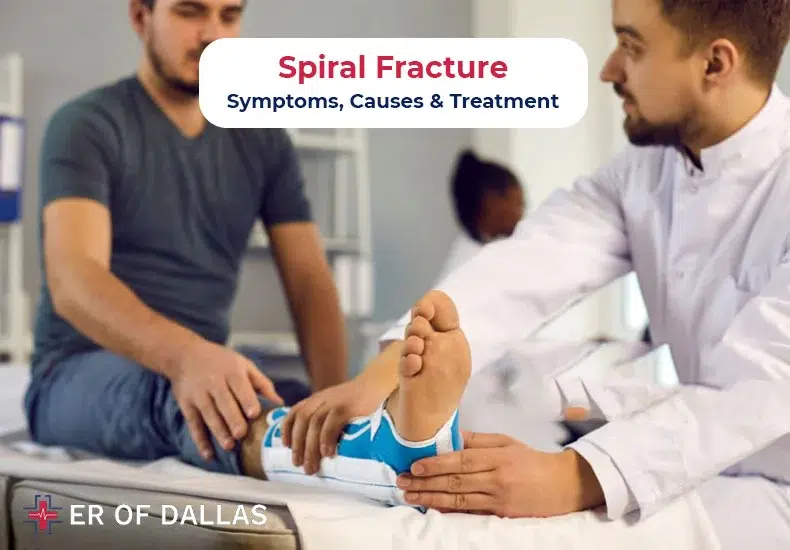Introduction
A spiral fracture is a serious type of bone injury that occurs when a rotating force is applied along the length of a bone. This fracture pattern often results from accidents, sports injuries, or falls. The spiral fracture recovery time varies depending on the severity of the fracture, the bone affected, and the treatment method used. Proper medical care, rehabilitation, and self-care practices can significantly influence the healing process.
Understanding Spiral Fractures
A spiral fracture happens when the bone is twisted with great force, causing it to break in a spiral pattern. These fractures often occur in long bones like the femur, tibia, fibula, humerus, and radius.
Common Causes of Spiral Fractures
Sports injuries – High-impact sports like football, skiing, or basketball can cause twisting injuries.
Falls – Landing with a twisting motion can result in a spiral fracture.
Motor vehicle accidents – Trauma from crashes can cause severe bone twisting.
Physical abuse – In some cases, excessive twisting of limbs can cause fractures.
Symptoms of a Spiral Fracture
Intense pain and swelling around the affected area
Difficulty moving the injured limb
Visible deformity in severe cases
Bruising and tenderness
Spiral Fracture Treatment Methods
Spiral fractures require proper treatment to ensure the bone heals correctly. Treatment options depend on the location and severity of the fracture.
1. Non-Surgical Treatment
Immobilization with a Cast or Splint – Mild to moderate spiral fractures can be treated with a cast or splint to keep the bone in place.
Pain Management – Doctors may prescribe pain relievers or recommend over-the-counter medications.
Physical Therapy – After the cast is removed, physical therapy helps restore movement and strength.
2. Surgical Treatment
Internal Fixation – In severe cases, metal plates, screws, or rods are inserted to hold the bone together.
External Fixation – A stabilizing device is placed outside the body to keep bones aligned.
Bone Grafting – If the fracture does not heal properly, a bone graft may be required.
Spiral Fracture Recovery Time
The healing process for a spiral fracture depends on factors such as age, overall health, the severity of the fracture, and the treatment method used.
Recovery Timeline:
1-2 Weeks: Initial Healing Stage
Swelling and bruising gradually decrease.
Pain levels may still be high but manageable with medication.
Limited mobility due to the cast or brace.
3-8 Weeks: Bone Remodeling Phase
Bone tissue starts regenerating and strengthening.
If surgery was required, follow-up X-rays monitor progress.
Light physical therapy may begin if advised by the doctor.
8-16 Weeks: Rehabilitation Phase
Gradual increase in weight-bearing activities.
Strength-building exercises help restore mobility.
Swelling and discomfort significantly reduce.
4-6 Months: Full Recovery
The bone fully heals in most cases.
Normal physical activities can be resumed with caution.
Continued physiotherapy may be required for complete strength restoration.
Factors That Influence Recovery Time
1. Age and Health Condition
Younger individuals tend to heal faster.
Health conditions like osteoporosis or diabetes can slow healing.
2. Severity of the Fracture
A simple fracture heals faster than a complex one.
Fractures requiring surgery take longer to recover.
3. Post-Treatment Care
Proper diet, rest, and rehabilitation play crucial roles in recovery.
Adhering to doctor’s instructions ensures faster healing.
Tips for Faster Recovery
Follow Medical Advice – Take prescribed medications and attend follow-up appointments.
Eat a Bone-Healthy Diet – Consume calcium-rich foods, vitamin D, and proteins.
Stay Active but Cautious – Perform recommended exercises to maintain mobility.
Get Enough Rest – Proper sleep and rest help the body heal faster.
When to Seek Medical Attention
Persistent pain or swelling even after weeks of treatment
Inability to move the limb despite recovery efforts
Signs of infection such as fever, redness, or pus discharge
Delayed healing or re-injury due to premature activity
FAQs
1. How long does it take for a spiral fracture to fully heal?
Most spiral fractures take about 4 to 6 months for full recovery, but this varies based on severity and treatment.
2. Can I walk with a spiral fracture?
If the fracture is in the leg, walking is restricted until healing progresses. Crutches or mobility aids are recommended.
3. Is surgery always required for a spiral fracture?
Not always. Minor fractures can heal with a cast, but severe cases may require surgery.
4. What foods help in bone healing?
Calcium-rich foods like dairy, leafy greens, and fish help strengthen bones.
5. Can a spiral fracture heal without a cast?
No, immobilization is necessary to ensure proper bone alignment and healing.
Conclusion
Spiral fractures require patience and proper care to heal effectively. Following medical advice, maintaining a healthy lifestyle, and engaging in rehabilitation exercises can speed up the healing process. If you experience any complications, consult your doctor immediately.
ER OF DALLAS – Providing Expert Emergency Care for Bone Fractures
If you or a loved one has suffered a spiral fracture, visit ER OF DALLAS for expert emergency medical care and treatment.
 :
https://erofdallastx.com
:
https://erofdallastx.com

